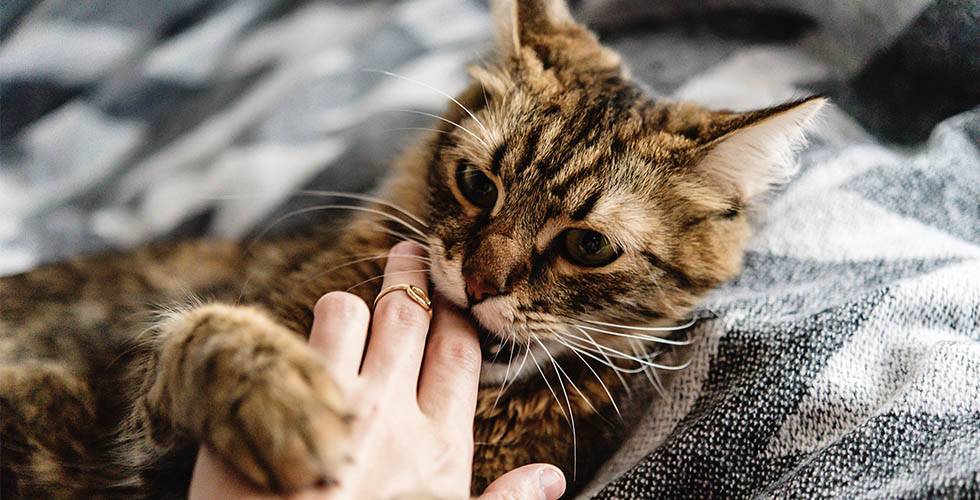Let’s face it, if you’re a cat owner, then you are well-aware of the ways a kitty can misbehave – from clawing up furniture, jumping on counters, or peeing outside the litter box. I have operated an animal rescue for over 10 years now and have seen all kinds of cat behavior, especially with my own cat Solo. There are some simple things you can do that will turn your misbehaving feline into a well-behaved cat almost overnight. Well, maybe not overnight, but he will quickly learn that these bad behaviors will get an immediate reaction from you that he’ll want to avoid in the future.
In this article, we will learn 7 methods to properly discipline your cat without getting physical. Hitting your cat will only make him distrust and fear you and will do nothing to change his bad behavior. We will also go over various training devices that work.
Our own story: I would like to mention an incident that happened with one of our rescues. We adopted out an affectionate and sweet adult cat named Sansa to an individual. 3 months later, Sansa’s new owner called us to complain that the cat was no longer approaching her, would flinch when she tried to pet her, and had become aggressive towards her. This was completely out of character from the kitty we knew. She then told us that when Sansa wouldn’t get off the bed, she would “smack” her to get her down. As a result of this frequent physical abuse, Sansa had grown fearful of her owner and had become withdrawn. We reclaimed the cat and have since placed her in a very good home away from physical abuse, but it took quite a while for her to trust again.
There are several disciplinary methods that can work for your cat, but you may need to try several ones before you find the one that works best. Whichever one you choose, there are some things to keep in mind first:
- Be consistent (Repeat, Repeat, Repeat): If you don’t want your cat jumping up on the counter or sharpening his claws on the couch, you must discipline him every single time he does it. Repetition is key. If you only discipline him some of the time, he won’t understand that what he is doing is wrong and will repeat the same bad behavior.
- Use the same word, firm voice, and different tone: Cats will learn to recognize certain words such as, “No,” “Stop,” or “Down,” if they hear them repeated often enough. Using a firm voice with a deeper tone than what you would normally use will ensure that your cat knows what he is doing is wrong.
- Reward your cat: If you want your cat to repeat a behavior, reward that behavior. Find out what motivates your cat and reward him immediately so he learns to associate good behavior with positive reinforcement. Treats will usually do the trick, but so can 10-15 minutes of playtime with his favorite human and a toy. Showering your kitty with attention and praise can also work.
- Teach good habits: A phrase we often use is, “Hands are for petting and toys are for playing.” Do not teach your cat bad habits by using your hand as a toy. We have had cats surrendered to our rescue because of biting issues. One owner couldn’t understand why his 2-year-old cat was biting his hand so hard, yet he was using that same hand to rough-house with the cat. Teach your cat or kitten now that your hand is OFF limits. If you see he’s in a playful mood, grab a toy!
- Keep your cat’s personality and age in mind: Remember that your cat needs to trust you before you can start disciplining him. If he is shy or skittish, he may need a slower introduction to the following methods. Older cats will need more time and patience as well, but it can be done.
7 EFFECTIVE WAYS TO DISCIPINE YOUR CAT:
Here are 7 methods you can use to train/discipline your cat without breaking his trust by becoming physical.
- The Water Method: When you catch your kitty doing something he shouldn’t, say a stern “NO,” followed by lightly spraying him with water from a spray bottle. This method is best used when your kitty is doing something like climbing curtains, eating plants or jumping on countertops.
- The Blow in the Face Method: I use this method most often as it is an easier and quicker way to discipline without getting up to grab a toy or spray bottle. When my cat bites my hand, I say a stern “NO,” and then blow in his face. This gets his attention and it usually only takes one or two blows for him to discontinue the bad behavior. This is also an easy method to teach your children and it is easy for them to do as well.
- The Loud Noise Method: Is your kitty attacking your feet? Or using your legs as a jungle gym? This would be a great time to say a stern “No” followed by a loud noise such as clapping your hands, shaking a soda can full of pennies, or making a loud “Shhhhooo” sound.
- The Relocation Method: If your cat is in a certain room doing something he shouldn’t, try picking him up, gently placing him in another area and closing the door. Make sure he has something to entertain himself with in the new location, such as a cat toy or scratching post. This method is best used if your cat is being naughty in a room that he can’t easily get back into.
- The Booby-Trap Method: This is ideal if your cat is jumping on counters or other surfaces. Set a booby trap by piling up boxes or light objects so that when your cat jumps, he will knock them over, thus scaring him off. You can even try using double-sided sticky tape or aluminum foil. He will begin to associate that surface with danger or unpleasant surprises and won’t jump up after a few encounters with the booby trap.
- The Diversion Method: Is your cat eating your favorite plant again? Stop that naughty behavior by distracting him with a toy or some other activity. Your cat is not being purposely defiant. Cats usually indulge in unacceptable behavior because they are bored. Give them some attention or another activity to partake in. There are plenty of interactive cat toys, including some that are battery-operated and will keep your cat busy for hours.
- The Unpleasant Smell/taste Method: Most cats do not like the smell of oranges and will usually avoid any area with this scent present. Try placing some orange peels around or buy orange-scented sprays. Many pet stores carry specifically made cat deterrents in a spray bottle that have an unpleasant smell and bitter taste. You can place this product on wires, cables, or on your indoor plants if you find your kitty chewing something he shouldn’t. Other odors they typically don’t like include vinegar, citronella, eucalyptus, wintergreen, aloe and strong perfumes, or colognes. Soak a cotton ball or pad with these scents and experiment to see which ones your cat seems to hate the most, then place them in the areas you want your cat to avoid.
Training Devices That Work! There are also training devices available in pet stores or online designed to keep your cat away from prohibited areas and surfaces. We have either used these devices ourselves or had positive reviews from our previous adopters:
- PetSafe ScatMat: A plastic electrical mat with a mild and harmless 3-second static pulse that responds to your pet’s touch. It will repel your cat from that surface and discourage him from pouncing on it in the future. Could be placed on your couch, car, or counter top.
- PetSafe SSSCAT Deterrent Cat Spray: A motion-activated device that emits a harmless, odorless, and stainless spray to repel your pet from that area. Great for keeping pets off counters, couches or other areas.
- Plastic Spike Mat: Many different variations, but all give the same results. Wherever these mats are placed, your pet will stay away from this area. Don’t worry, these mats are not sharp enough to injure your cat.
- CatScram Electronic Cat Repellent: This device detects motion and sends out a high-pitched electronic squeal that frightens cats away quickly.
- Tall Scratching Posts: You may be wondering why this is included here, but cats are instinctive scratchers so embrace this behavior! Give your cat one or more stable scratching posts (33” tall works well) so he chooses this over your couch! Offer different materials like sisal, carpet, wood and cardboard, as well as different styles (vertical or horizontal). Use catnip on or around the scratching post to entice them. There are also plenty of DIY sites online that will show you how to make a scratching post yourself. With our cat Solo, we have 3 various cat scratching posts/boards around our home.
PRO TIPS:
- Never hit your cat! There are no exceptions to this rule. It is never okay to hit your cat or any animal for any reason. If you do, you will not be teaching your cat good behavior. You will only be teaching him to distrust and fear you. Yelling also does not help any situation and could also cause your cat to become fearful of you.
- Only discipline your cat if you catch him in the act. Disciplining him after he has already misbehaved will only upset and confuse him. He won’t associate his past bad behavior with the disciplinary action.
- Learn to cut your cat’s nails. Learning to cut your kitten’s or cat’s nails can really help save your furniture while you are teaching him the right places to scratch. There are quite a few videos on YouTube that will walk you through the process and you can use regular nail clippers for humans. We cut our own kitten’s nails every 2 weeks (set your phone to remind you). For more info and tips on cutting nails, click here.
- Litter box issues: This is a common issue with many cat owners. Here are a few things to consider. If you find that your cat is litter box trained but doesn’t always use it, there could be several other reasons besides him just misbehaving. The litter box itself could be the problem. Make sure the litter box is clean and is in a safe, calm and relatively private area. Clumping litter makes it easier to keep the litter box clean and also cuts down on odor. Litter should also be kept about 3 inches deep. Your cat may be upset or anxious for some reason. Sometimes cats temporarily show their displeasure by urinating outside the litter box when there is a new addition to the household, whether human or animal. Once a urinary tract issue has been ruled out by a veterinarian, you may have to try one or more disciplinary methods before you find the one that works best for you. To learn more on urinary tract problems, Click here OR why wet food is a must in all cat’s diet-click here.
TO SUM IT UP:
Training a cat may be harder than training a dog, but don’t let this discourage you. With a little time, patience, and consistency, it can be done! Keep in mind that the purpose of discipline is teaching, not punishing. You want to teach your cat while maintaining mutual trust and a strong bond.

